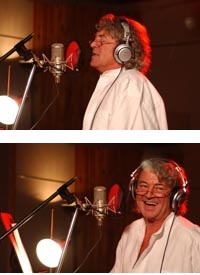30 Minutes with Ian Gillan Page 3
 Machine Head was one of the first surround releases in 2001, one we really liked when it came out. I remember that. Roger [Glover] worked on it, I think. I was really impressed with that, especially after the nightmare of the original transfer to CD from vinyl, when nobody did anything to the tapes. Everything was flat. Awful. The 25th anniversary reissue [in 1997] was the first time it sounded better than the vinyl.
Machine Head was one of the first surround releases in 2001, one we really liked when it came out. I remember that. Roger [Glover] worked on it, I think. I was really impressed with that, especially after the nightmare of the original transfer to CD from vinyl, when nobody did anything to the tapes. Everything was flat. Awful. The 25th anniversary reissue [in 1997] was the first time it sounded better than the vinyl.
I'd like to go over a track from Gillan's Inn that everybody knows really well, "Smoke on the Water." Having that vocal chorus in the rears gives it a special impact, and I like how you kept Steve Morse's guitar solo in the front with some percussion going on in the rear. The cymbal rides are placed nicely in the back, too. Overall, it's not too gimmicky, and it sounded really cohesive to me. Thanks. You sometimes sacrifice certain things to gain less, but it works. I'd need to listen to it a few more times to really understand everything that's going on there. Surround is another dimension. Rock music is what it is. I think the value of it went away a lot in the 1980s because recording itself evolved into a process, not a performance.
Gated drums, anyone? Yeah, right. [chuckles] And overdub, overdub, overdub. It was monstrous. It was new, but on reflection, it didn't have soul to it. And I don't think you can justify technology if it destroys the soul. If you can have both. That usually comes at a later date, when one or the other has died or been forgotten - referring back to the quadraphonic thing - then you're lucky enough to pick it up again. We're lucky now that people probably from other perspectives have brought us 5.1. It certainly enhances not only the overall experience but the individual performances - you can actually hear what people are doing. Great musicians tend to get lost in the wall of sound sometimes.
You've recorded numerous tracks that listeners can lose the sense of in certain stereo mixes. We'd ping-pong them, working on a 4-track. Once you got the rhythm tracks down, you had two tracks left. And you couldn't use both, because that would be the end of the road. You had to keep one track open so each time you recorded, you bounced down to the one track; a new generation every time. Then it would [makes warbly noise], and you'd have to crank the treble. All the subtleties got lost.




























































